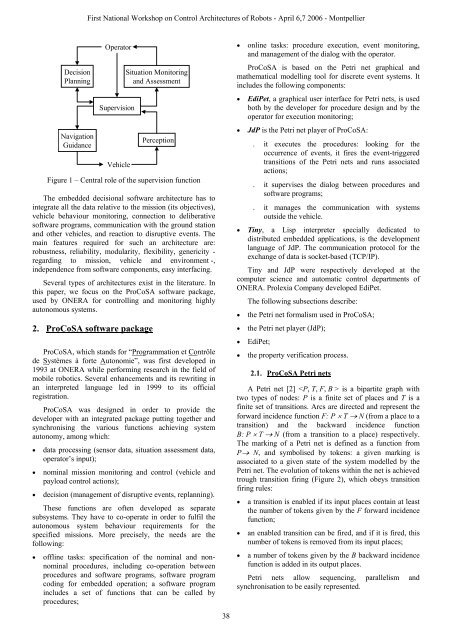Pleading for open modular architectures - Lirmm
Pleading for open modular architectures - Lirmm
Pleading for open modular architectures - Lirmm
Create successful ePaper yourself
Turn your PDF publications into a flip-book with our unique Google optimized e-Paper software.
Decision<br />
Planning<br />
Navigation<br />
Guidance<br />
First National Workshop on Control Architectures of Robots - April 6,7 2006 - Montpellier<br />
Operator<br />
Supervision<br />
Vehicle<br />
Situation Monitoring<br />
and Assessment<br />
Perception<br />
Figure 1 – Central role of the supervision function<br />
The embedded decisional software architecture has to<br />
integrate all the data relative to the mission (its objectives),<br />
vehicle behaviour monitoring, connection to deliberative<br />
software programs, communication with the ground station<br />
and other vehicles, and reaction to disruptive events. The<br />
main features required <strong>for</strong> such an architecture are:<br />
robustness, reliability, <strong>modular</strong>ity, flexibility, genericity -<br />
regarding to mission, vehicle and environment -,<br />
independence from software components, easy interfacing.<br />
Several types of <strong>architectures</strong> exist in the literature. In<br />
this paper, we focus on the ProCoSA software package,<br />
used by ONERA <strong>for</strong> controlling and monitoring highly<br />
autonomous systems.<br />
2. ProCoSA software package<br />
ProCoSA, which stands <strong>for</strong> “Programmation et Contrôle<br />
de Systèmes à <strong>for</strong>te Autonomie”, was first developed in<br />
1993 at ONERA while per<strong>for</strong>ming research in the field of<br />
mobile robotics. Several enhancements and its rewriting in<br />
an interpreted language led in 1999 to its official<br />
registration.<br />
ProCoSA was designed in order to provide the<br />
developer with an integrated package putting together and<br />
synchronising the various functions achieving system<br />
autonomy, among which:<br />
• data processing (sensor data, situation assessment data,<br />
operator’s input);<br />
• nominal mission monitoring and control (vehicle and<br />
payload control actions);<br />
• decision (management of disruptive events, replanning).<br />
These functions are often developed as separate<br />
subsystems. They have to co-operate in order to fulfil the<br />
autonomous system behaviour requirements <strong>for</strong> the<br />
specified missions. More precisely, the needs are the<br />
following:<br />
• offline tasks: specification of the nominal and nonnominal<br />
procedures, including co-operation between<br />
procedures and software programs, software program<br />
coding <strong>for</strong> embedded operation; a software program<br />
includes a set of functions that can be called by<br />
procedures;<br />
38<br />
• online tasks: procedure execution, event monitoring,<br />
and management of the dialog with the operator.<br />
ProCoSA is based on the Petri net graphical and<br />
mathematical modelling tool <strong>for</strong> discrete event systems. It<br />
includes the following components:<br />
• EdiPet, a graphical user interface <strong>for</strong> Petri nets, is used<br />
both by the developer <strong>for</strong> procedure design and by the<br />
operator <strong>for</strong> execution monitoring;<br />
• JdP is the Petri net player of ProCoSA:<br />
. it executes the procedures: looking <strong>for</strong> the<br />
occurrence of events, it fires the event-triggered<br />
transitions of the Petri nets and runs associated<br />
actions;<br />
. it supervises the dialog between procedures and<br />
software programs;<br />
. it manages the communication with systems<br />
outside the vehicle.<br />
• Tiny, a Lisp interpreter specially dedicated to<br />
distributed embedded applications, is the development<br />
language of JdP. The communication protocol <strong>for</strong> the<br />
exchange of data is socket-based (TCP/IP).<br />
Tiny and JdP were respectively developed at the<br />
computer science and automatic control departments of<br />
ONERA. Prolexia Company developed EdiPet.<br />
The following subsections describe:<br />
• the Petri net <strong>for</strong>malism used in ProCoSA;<br />
• the Petri net player (JdP);<br />
• EdiPet;<br />
• the property verification process.<br />
2.1. ProCoSA Petri nets<br />
A Petri net [2] is a bipartite graph with<br />
two types of nodes: P is a finite set of places and T is a<br />
finite set of transitions. Arcs are directed and represent the<br />
<strong>for</strong>ward incidence function F: P × T → N (from a place to a<br />
transition) and the backward incidence function<br />
B: P × T → N (from a transition to a place) respectively.<br />
The marking of a Petri net is defined as a function from<br />
P→ N, and symbolised by tokens: a given marking is<br />
associated to a given state of the system modelled by the<br />
Petri net. The evolution of tokens within the net is achieved<br />
trough transition firing (Figure 2), which obeys transition<br />
firing rules:<br />
• a transition is enabled if its input places contain at least<br />
the number of tokens given by the F <strong>for</strong>ward incidence<br />
function;<br />
• an enabled transition can be fired, and if it is fired, this<br />
number of tokens is removed from its input places;<br />
• a number of tokens given by the B backward incidence<br />
function is added in its output places.<br />
Petri nets allow sequencing, parallelism and<br />
synchronisation to be easily represented.

















